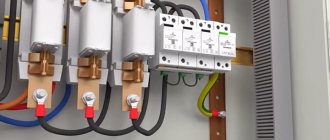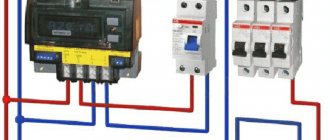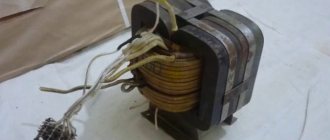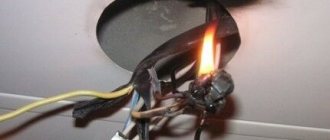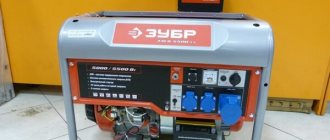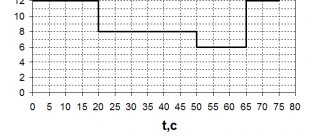The main purpose of the RCD is to disconnect the entire electrical network or its individual section from the power supply by opening the contacts. This ensures protection against electric shock and fire prevention. In modern electrical engineering, the use of these devices in many cases becomes mandatory, therefore, the question often arises of how to choose the right RCD. These protective devices are used not only in single-phase, but also in three-phase networks under various loads, therefore, their selection is made depending on the specific operating conditions.
Purpose of RCD and principle of operation
The main task of the RCD is to neutralize currents when various damage occurs in electrical installations. The residual current device is the most effective protective device. Unlike fuses or circuit breakers, RCDs are capable of breaking a circuit in a split second and saving a human life.
The danger is not only the possibility of direct electric shock. Sometimes simply touching the parts of live devices and devices is enough. Therefore, protective devices must operate in a timely manner. In order to correctly solve the problem of how to choose an RCD for a home, the conditions in which it will operate must be taken into account.
The operation of protective devices uses the phenomenon of electromagnetism. In this regard, the design of the RCD includes coils with a magnetic core connected to current-carrying wires that transmit electricity to the consumer. At the same time, a magnetic flux occurs, which is the arithmetic sum of the currents flowing through these conductors. In this case, the incoming currents have a positive value, and the outgoing currents have a negative value. In the absence of leaks and short circuits, they will be equal and add up to zero. This state of the circuit indicates the serviceability of the installed equipment.
In the event of a leak, a partial reverse flow of current occurs through the grounding conductors, which leads to an imbalance. The difference in differential currents causes the excitation of magnetic flux in the core. Its value will be proportional to the difference in electric current. When a certain threshold is reached, the device is triggered and turns off the power supply to consumers.
Existing types of RCDs
Electricity leakage in the network determines the existing types of devices. So, for example, when there is alternating current, RCDs of one type are switched off, while others are switched off when the current is alternating and pulsating.
AC-type RCDs will turn off when there is an instantaneous alternating current leak (lighting, convectors, refrigerator, heated floor, etc.). The icon on the front indicates AC type. This type can also be designated “AS” or two designations at once.
An A-type RCD is simultaneously sensitive to alternating and pulsating electricity leakage; it can occur instantly or slowly increase. In modern washing machines and dishwashers, PCs, TVs, microwaves and other electronically controlled household appliances, rectifiers and switching power supplies are used. There are modern household appliances that use A-type protective devices.
- designation of this type of ouzo.
It is also necessary to emphasize that the protection zone of the A-type is higher than that of the AC type, which determines their higher cost. However, if it is not possible to install an A-type RCD, it is better to at least have an AC one. This will provide at least minimal protection.
PUE 7.1.78 does not prohibit the use of devices AC (they are sensitive to alternating current leakage) and A (they react to alternating and sensitive fault currents). Examples of pulsating electricity include computer equipment, televisions, dishwashers, light sources that can be regulated, etc.
To better understand which type of RCD is optimal for a specific household appliance, you should first carefully read the instructions for its use. As a rule, manufacturers provide recommendations.
AC-type devices are prohibited from being used in Europe, only A-type RCDs. B-type RCDs are extremely rarely used in the Russian Federation. An example of a place for using these RCDs would be industrial enterprises where leaks of rectified electricity occur, etc. B-type equipment is not used in everyday life.
How to choose the right RCD
In order to select the best option for a residual current device, you need to know its basic parameters. Devices with different characteristics are used in specific conditions, which must be taken into account when choosing. The nature of leakage currents allows us to divide them into different types. This division depends on a smooth or sudden increase in current. RCDs with such characteristics are most widespread as they are most suitable for the widest operating conditions.
Triggering technology allows RCDs to be divided into electromechanical and electronic. In the first case, high-precision mechanisms are triggered as a result of leakage currents. These are the most reliable and expensive devices capable of operating under any conditions. Electronic devices are cheaper, however, for normal operation of the electronics, the use of external power is required. Their efficiency is significantly reduced when voltage surges occur. The response speed of RCDs allows their use in multi-level protection systems. This allows you to turn off all emergency sections individually.
There are other parameters that require knowledge of electrical engineering. Therefore, when choosing an RCD, it is best to seek help from qualified specialists. However, if the exact characteristics of the electrical network are known in advance, you can independently select the most suitable protective device. Among them, the most important are the following:
- Voltage. The RCD can be designed for a single-phase network with a voltage of 220 V or a three-phase network with a voltage of 380 V. The first option is usually used in apartments, and the second in private houses, dachas and cottages. If there are sections with one phase in three-phase wiring, then protective devices designed for 220 volts are used for them.
- Number of poles. In single-phase networks, two-pole RCDs are used, designed for one phase and zero, and in three-phase networks, four-pole devices are used, to which three phases and zero are connected.
- Rated current. This is also the throughput current of the RCD, which depends on the number and power of connected electrical appliances and equipment. Therefore, this indicator for a general (input) protective device must be calculated for all installed consumers. For linear RCDs, the total power is calculated based on the number of devices on a particular line. The RCD ratings set by the manufacturers are 16, 20, 25, 32, 40, 63, 80, 100 A.
- RCD leakage current. The value upon reaching which it turns off. It also varies in ratings of 10, 30, 100, 300 and 500 mA. For ordinary apartments, a 30 mA device is best suited. With a lower current rating, the device will constantly respond to even minor fluctuations in the network and turn off the power.
- Type of leakage current. The symbols AC, A, B, S and G are marked on the body of the device. For example, AC reacts only to alternating leakage current, and B - to direct and alternating currents. The rest of the markings also correspond to certain parameters, including the device shutdown time delay.
Leakage current value (mA)
RCD leakage current is the value to which the protection device reacts, i.e. turns off. The minimum leakage current is 10 mA, and the maximum is 500 mA. Many experts recommend installing residual current devices at home that are triggered by a leakage current of 30 mA. And I agree with them.
An RCD with a leakage current of 10 mA will respond to the slightest fluctuations in the home network. It is also necessary to take into account that many electrical appliances have their own natural leakage currents. They are very small, but still there. And if they are summed up, then your RCD will turn off every 5 minutes! This is if the wiring is new; if not, then there will also be a leakage current in it. RCDs with a large rating (for example, 500 mA) respond only to high currents, which is fraught with trouble. It's not worth the risk.
What types of RCDs are there?
The main classification of residual current devices is based on their operating current. For example, fire protection devices respond to currents of 100, 300 and 500 mA. They protect wiring from fire in the event of insulation failure and short circuit. Typically, an introductory RCD is installed behind the electric meter and provides protection for the entire facility. For people, electric current becomes dangerous at 50 mA. Therefore, devices that protect against fire are not able to protect a person from electric shock. For these purposes, devices are used that turn off the network when the current reaches a value of 10 or 30 mA.
Protective devices differ in the number of poles and can be used in single- or three-phase networks. Each type of device has a different way of functioning. The markings on the body of the device must be correctly deciphered and you need to know exactly what it means:
- AC is a category of RCD used only in alternating current networks. Accordingly, the device responds only to alternating current.
- A - protective devices of this category operate not only with alternating current, but also with direct current.
- B – has more advanced functions and responds to three types of current. In addition to direct and alternating current, the device turns off with rectified differential current.
- S – selective devices with the possibility of time delay when switching off.
- G – are also selective devices, but with a shorter time delay.
RCDs are also classified according to their technical design. This allows you to select a RCD of better quality. Most often, electromechanical devices are used that do not have their own power supply. They operate and shut down when a differential current appears.
Another type refers to electronic protective devices that require connection to an external power source. In this regard, the reliability of protection decreases, so such RCDs are used less frequently. When the auxiliary power is turned off, they turn off the network automatically, and when the power is restored, the network also turns on automatically. Some device designs do not provide for automatic switching on of the circuit when the power supply is restored.
Fire protection RCD connection diagram
A current of 100 mA is fatal for a person in an alternating voltage network, therefore, to protect electrical appliances, RCDs with a setting of 10 or 30 mA are used. cannot protect against electric shock , so such devices are installed in the incoming electrical panels for emergency shutdown of the entire building. This ensures selectivity of protection.
A fire protection RCD disconnects power cables and circuit breakers, allows you to disconnect only the section in which there is a short circuit and reduces the number of false alarms.
For example, if water gets on the electronic board of a washing machine, the line supplying it will turn off, but all other electrical appliances will remain on.
In some situations, instead of this device, it is advisable to install a difavtomat with the same protective parameters. This allows you to save space in the electrical cabinet or improve protection by replacing a conventional circuit breaker with a differential circuit breaker.
How to choose an RCD based on power
Unlike circuit breakers that protect against overloads and short circuits, residual current devices are designed to protect against current leakage. The reason is faulty insulation of electrical appliances or contact of live parts with the housing. In these cases, the RCD is instantly turned off, the line is de-energized, and consumers are protected from electric shock.
In order to calculate the RCD by power, you need to know the total number of consumers connected to a given line. In the case when the question of how to select an RCD and a circuit breaker based on power is being decided, both protective devices must have appropriate values to ensure their normal operation. If the installation of circuit breakers is not provided for by the project, in this case the total power consumed by electrical appliances is calculated. As a rule, this value in a standard apartment in a multi-storey building does not exceed 25A.
When installing RCDs in private houses, it is recommended to divide all consumers into groups connected to separate lines extended to each floor, outbuildings, external lighting, etc. If the RCD has less power than the existing consumers, it will constantly turn off due to overloads. That is, the device will actually not work normally and will not be able to protect the line. Sockets with RCDs built into them, designed for a current consumption of 5A, will help partially solve this problem.
What rating should I choose for a 100 or 300 mA RCD?
When choosing a fire protection RCD, the question arises - what parameters should the device have? If everything is simple with the rated current, it must be equal to or greater than the corresponding circuit breaker, then the setting current depends on the installation location of the device.
In the apartment panel, 100mA is enough, and on the floor it is advisable to install a device with a setting of 300mA.
If there is no fire protection RCD in the apartment panel, the device with a setting of 100 mA is located in the floor or common building panel. The general rule when choosing the operating current is the following - the lower, the better. The leakage power even in a 100mA device is 22W, which corresponds to an average power soldering iron.
Regulatory documents for use
Whether a fire protection RCD is needed and what parameters this device should have is indicated in various regulatory documents.
- GOST R 50571.17-2000 482.2.10. This GOST specifies safety measures to reduce or prevent the effects of leakage current on equipment or cables. To do this, it is necessary to install an RCD or differential circuit breaker with a setting current of no more than 500 mA. Instead of installing a UDT, it is allowed to constantly use a device that monitors the insulation resistance and, in case of its violation, sends a signal and (or) turns off the power.
- SP 256.1325800.2016 10.13. These rules provide measures to protect against fire of electrical wiring in an apartment or private house. To turn off the power if the ground leakage current is insufficient to trip the circuit breaker, it is necessary to install a differential protection device with a setting current of no more than 300 mA in the input panel.
- GOST R 50572.4.42-2012. This document provides methods for protecting electrical wiring from fire. To do this, the setting current of a difavtomat or RCD in an apartment or private house should not exceed 300 mA.
The required parameters of protective devices are based on research by the All-Russian Research Institute of Fire Defense (VNIIPO EMERCOM of the Russian Federation). According to data provided by this institution, the power released at the leak site at a current of 150 mA (33 W) is sufficient to heat the damaged insulation to the ignition temperature.
Conclusion
Summarizing the above, we can define several rules for selecting and installing differential protection devices:
- the rated current of the UDT is determined by the input circuit breaker and must be equal to or greater than the circuit breaker;
- groups of electrical appliances and individual lines are connected to an RCD with a setting of up to 30mA ;
- in the input panel of apartments and small houses after the electric meter, devices with a setting of 100 mA are installed; in cottages, shops and other buildings and premises of a large area, devices with a setting of 300 mA are used;
- At the input of commercial objects, selective RCDs or difavtomats are used (marked “S” on the front panel).
The main purpose of such devices is to protect electrical wiring from fire. Therefore, in apartments and private houses it is necessary to use both types of devices - conventional and fire-fighting RCDs.
How to calculate RCD
In order to calculate the protective device and solve the problem of how to choose an RCD based on power, the table of parameters will help you do this as quickly and accurately as possible. It is necessary to use two technical characteristics - leakage current and maximum current - to obtain the desired result. The calculations use a mains voltage of 220 V, with a frequency of 50 Hz.
Calculation and selection of the maximum current rating of the RCD is quite simple. It is necessary to establish the value of the total electrical power of devices and equipment turned on simultaneously. For example, if this indicator is 6000 watts, then the calculated current value will be equal to: I = P/U. Substituting the required values into the formula, we get the result: 6000W/220V = 27A. The closest RCD from the standard range of rated currents will be 32A.
If the RCD is calculated based on leakage current, in this case a simplified scheme is used, according to which various types of protective devices are selected in accordance with the operating conditions of the objects:
- In ordinary residential premises - at 30 mA.
- In bathrooms, kitchens and other rooms with high humidity and higher requirements for electrical safety - 10 mA.
- At large facilities with electrical networks over 1000 m in length or at the input - 100 mA.
Quite often there is a need to select an RCD for a group of machines, the calculation of which is carried out according to certain rules. The installation of these devices in the circuit is carried out sequentially; the machines can be installed both before and after the RCD. The current values of the circuit breakers must be lower than in the RCD, but not less than the actual current consumption. Correct calculation of RCDs and circuit breakers shows that in the event of overloads and short circuits, the circuit breaker will protect not only the line itself, but also the residual current device installed on it.
Types of RCD triggering
According to this criterion, there are electronic and electromechanical devices. The first option will be cheaper in price, which can be explained by a cheaper production process, however, the reliability of such devices is lower. The power of the first option comes from the network, and the quality of its functioning is determined by the parameters and quality of the electrical network.
Let's look at this in more detail using a simple example. The zero phase burned out in the electrical panel on the floor of a building on several floors; accordingly, the electronic type device will turn off and be inoperative (it needs power to work). If a short circuit occurs and someone touches it, the device will not respond. Electronics may also break down, especially if the Chinese device is of poor quality.
As for the second version of devices, they can be characterized as more reliable; they are not influenced by the state of the network. It is for this reason that it is optimal to use them.
Their work is based on comparing the electricity that leaves and enters the device. The device will turn off if the electricity is unequal to the setpoint or greater than it.
These diagrams allow you to understand which version of the device: electronic or electromechanical. The operation diagram is applied on the front side of the device body.
ABB, Schneider Electric, Hager, Legrand and other well-known manufacturers produce exclusively electromechanical devices, which is why they have been able to earn a reputation as manufacturers of RCDs of the highest quality and reliability.
The following picture shows a cross-section of electronic and electromechanical devices, which makes it possible to compare them from the inside. An example of an electronic device made in China, because, as already mentioned, well-known brands produce exclusively electromechanical RCDs.
Which RCD should be installed at the entrance to the apartment?
In modern high-rise buildings it is prohibited to use three-phase wiring, so many owners are wondering how to choose an RCD for an apartment. Meanwhile, there is nothing complicated here, since for single-phase wiring a two-pole device marked AC is used. Based on the leakage current, the RCD for the apartment is selected at the rate of 30 mA. Devices with a lower shutdown threshold may cause false alarms.
How many RCDs should I install in an apartment? It all depends on the total power of consumers. If it is too large, it is recommended to split the home network into separate lines and install a protective device on each of them. Additionally, a general RCD is installed at the entrance to the apartment to protect against fire if the insulation is damaged.
Often false alarms occur due to old electrical wiring. If these processes occur systematically, it may require complete replacement.
Types of devices depending on when they are turned off
Devices, depending on the time that is maintained before they operate, exist in the following types:
- there is no holding time. The purpose of devices of this type is to perform a protective function against electric shock or fire in the event of wiring failures. RCDs of this type are the primary protection; they are most often installed on the lines of power receivers;
- fireproof or S-type. They turn off in 0.2-0.5 s. It can only protect against fire, but not against injury or electric shock. Such a device is placed near the input machine only at the beginning of the line. Provides a second degree of fire protection, connects automation in the electrical panel and protects the input cable. Selectivity is indicated by the presence of the “S” designation on the front side of the device.
Below you can see examples of a fire protection RCD for one phase at 100 mA from the manufacturer ABB and for 3 phases and 300 mA from the manufacturer Schneider Electric.
The leakage rating of an S-type RCD can range from 100 to 300 mA. They provide second degree protection. Existing installation requirements stipulate that the degree of response time delay and the electricity setting, if several RCDs are installed on the same line, for each subsequent installation exceed the previous one.
When RCDs are installed, in accordance with SP 31-110-2003 (clause A.4.2), all selectivity requirements must be strictly observed. When the RCD circuit is two- and multi-stage, devices near power sources should have a higher response time and response current setting than those located near electricity consumers.
If there is a power leak and there is no time delay, and there are two devices on the line (30 and 100 mA), they would trip together, and the most powerful RCD in the entire building would turn off the electricity. It follows that you need to choose a fire-fighting device that is installed in an outdoor electrical panel to ensure high-quality fire protection.
There are also G-type RCDs. It is similar to the one described above, but its exposure time is 0.06-0.08 s. This is a pretty rare type. Having ordered such a device, you have to wait several months for it, which causes certain inconvenience.
RCD selection
How to choose the right device for your shield? There are many criteria to consider here. If you discard at least one of them “especially if it is important”, you can get the consequences described above
What should you pay attention to? Now we will tell you about it
Rated load current
Any machine and RCD are designed for a certain rated current. Selecting a device based on this criterion is not difficult: you just need to look at the value on the machine and select the protection with the highest one. So, for a 16 A machine you need a 25 A RCD. It is not worth installing both devices with the same value: in this case, the shutdown will not happen immediately, and during this time anything can happen.
Differential current
Here we need to return briefly to the previous point. The fact is that if you set a device with greater sensitivity to a high rated current, it can often trigger. But there is one “but” here. The fact is that for your home you cannot choose an RCD with a leakage current setting greater than 30 mA, since a higher voltage can be harmful to health.
Therefore, the differential indicator should be greater than the nominal value only if it does not exceed 30 mA. For bathrooms, the value should be no more than 10 mA, since there is high humidity.
But what about devices with high value, you ask. The fact is that they are intended not only to protect people and household appliances. If the setting is higher than 30 mA “for example, 100”, then such devices are intended to prevent fires due to leakage “for example, in production”.
Type of protective device
We figured out how to choose an RCD and an automatic machine based on power. Now let's find out how products are divided by type. True, it is also divided into two subspecies based on two characteristics. One of them is a type of leakage current. According to it, RCDs are:
- for alternating current “type “AC”. Such devices are the cheapest. Previously, they could be chosen by household consumers, but today it is better not to pay attention to such a product, since many appliances “for example, a washing machine or computer” do not use alternating current;
- for alternating and constantly pulsating currents “type “A”. This RCD is ideal for houses and apartments. Yes, they are more expensive than the previous ones, but they are no longer useless;
- for alternating, constantly pulsating and rectified currents “type “B”. It can also be used at home, but there is no reason: rectified current is not used in apartments, that is, there is no need to protect against its leakage, and the cost of such protection will amount to a tidy sum. This type is installed, again, in production, where all types of currents are used.
We're done with the first sign. Let's move on to the second - response time. As a rule, for apartments they choose conventional RCDs, which turn off the home network after 20-40 ms. In addition to them, there are two more types with delayed shutdown:
- type "S". Triggers after 150-500 ms, used as input;
- type "G". “Switches off” the house after 60-80 ms, placed on a separate device.
Why is such an RCD needed? After all, during this time you can get an electric shock! The fact is that a conventional device may fail and not work at all. Therefore, they are placed on a certain group of machines. If they don’t work, after some time the usual “comes into play.”
Inspection of the apartment with pre-finishing finishing
The area must be prepared for the next renovation; window units, entrance and interior doors, radiators, and partitions must be installed.
The intermediate option involves minimal work:
- screed;
- plaster;
- plumbing and electrical wiring.
The bathroom must have waterproofing that extends to the walls above the screed, and wiring from the riser to future plumbing fixtures.
It is necessary to ensure that the joints at the pipe connections are tight. To level the floor, a concrete or cement screed is used. Large defects are visible without tools. The flatness of the coating is checked using a rule that is laid on the base and the gaps are visually determined. A laser level gives more accurate results. A deviation of 2 mm from the plane per 2 meters of length will allow you to lay rolled materials, parquet, and laminate.
A simple type of plaster consists of spraying the base and soil, which makes the surface even, almost smooth.
Permissible deviations
| Defect | Maximum deviation | |
| 1 | Irregularities (a rule is applied to determine) | Depth and height up to 5 mm |
| 2 | Number of irregularities in an area of 4 m2 | Up to 3 pieces |
| 3 | Horizontal difference along the entire length of the room | 15 mm |
| 4 | Difference in vertical area by 1m2 | 3 mm |
| 5 | Vertical deflection at full height | 15 mm |
You can see how the quality of plastering work is checked here
RCD: electronic or electromechanical?
If you value life, definitely electromechanical. Electronic RCDs have only one advantage over electromechanical ones - low cost. But this advantage pales in comparison to its main drawback - the energy dependence of the circuit. If the neutral conductor breaks, this device becomes inoperable. Imagine one of the possible situations. The lights go out at home: the zero has burned out in the switchboard on the staircase. There is phase voltage on the body of the washing machine (this often happens when the heating element burns out and other malfunctions), while a person is standing in a bathtub filled with water and touching the body of the washing machine in the dark. The outcome is predetermined...
Electronic RCDs, unlike electromechanics, are also sensitive to all kinds of electromagnetic interference, and the reliability of the electronic filling cannot be compared with the mechanical one. So choose: spend a few hundred “extra” rubles or get an electrical injury, often incompatible with life.
The only option when I consider it acceptable to use an electronic RCD is to include it in a series circuit with an electromechanical one. For example, at the entrance to the house there is first a circuit breaker, then a so-called “fire-prevention” (this term always evokes slight irony for me...) electronic RCD, and after it there is always an electromechanical one with low differential shutdown currents to protect people from electric shock.
Choosing an RCD for an apartment and a house - a checklist in 10 steps.
The choice of the RCD itself largely depends on these parameters.
Do not forget that an RCD is necessary not for protection against short circuits or overloads (automatic machines handle this matter), but to protect a person from electric shock.
To choose the right RCD for your panel room, go through the 10-step checklist, and you can easily decide on the right protection device for your house or apartment.
First of all, you need to decide on the quantity. That is, how many RCDs do you generally need to install in the electrical panel? Is one enough for the whole house or is it advisable to protect every line?
The most common and economical option is the installation of ONE input RCD. And this is also correct and there is no mistake here.
However, this statement is true until the first serious accident.
But here it all depends on your groups and connected pantographs.
1 First, install an RCD on every device that is in one way or another in contact with water .
3 Thirdly, another RCD necessarily goes to the common group of sockets. In the vast majority of cases, this amount is more than enough.
If you have a single-phase 220V network, then choose a 2-pole RCD.
If the house has a 3-phase 380V, then there is a richer choice here. Either one 4-pole or 3 two-pole per phase.
Here look at the nature of the load (3-phase motor - then 4-pole). A single-phase 220V load is uniformly connected across all phases - three two-terminal networks.
There are electronic and electromechanical RCDs. You can distinguish them by the inscriptions on the body.
The electronic one has a diagram with a polarized relay in the form of the letter “A” in a triangle.
El.mechanical does not have such a designation.
Which one is better? El.mechanical RCD is considered more reliable, so it is recommended to choose it.
Protects only against leakage in alternating current networks.
Provides protection against leakage on both alternating and pulsed current (modern TVs, power supplies, computers, etc.).
Required for switchboards with a large number of RCDs (on the main input and outgoing lines), in the so-called cascade circuits.
They provide selectivity in which the ouzo at the main input is triggered last.
The RCD responds to alternating, pulsating, direct and smoothed current.
In Europe, in some countries (for example, Germany), the type of speaker is even officially prohibited by the rules in force there.
The leakage current is actually the sensitivity of the ouzo. In order not to rant in theory, we will present ready-made options based on existing recommendations and standards.
This also includes all consumers, the so-called “wet” group, who work with water.
By rated current we mean the maximum amount of current that the device can withstand for a long time without melting or damaging its contacts and other components.
Roughly speaking, it will work as if nothing had happened, retaining all its protective functions.
Do not be confused, if this value is exceeded, the RCD will not turn off! The circuit breaker should do this for him.
The main rule here is that the rated current of the RCD must be equal to or be one step higher than the current of the circuit breaker protecting this section of the circuit. That is, a machine that is located after the RCD.
Please note that many manufacturers simply do not have an ouzo for 32A. Basically, this denomination is found only among Chinese comrades. Therefore, the choice in the plate Inom = 40A is due precisely to this.
If your RCD is located at the input, then its current should be one step greater than or equal to the current of the input circuit breaker.
When several consumers with different circuit breakers are connected to one RCD in a group, then focus on the sum of their currents.
But what if this amount turns out to be even greater than the current of the input switch? Then take into account the introductory machine.
If you are completely confused in these calculations, you can use a convenient mnemonic diagram for selecting an RCD from KonstArtStudio.
Just answer a couple of questions in the navigation blocks and you will get the desired result.
In addition to the rated current, there is also such a value as the conditional short circuit current. Well, that is, when a short circuit occurs in the wiring, what is the maximum current the RCD can pass through itself for a short time without being destroyed.
Today, select devices with a parameter of at least 6000A .
This parameter must be at least 10 times the rated current or equal to 500A.
It all depends on the design and quality of the contacts. RCDs from reputable manufacturers have a rated switching capacity of 1000A or 1500A.
They have a special badge on their body.
Here we will not recommend a specific brand; there are already enough good companies, and they are all well-known:
Source
How to choose the number of RCDs per apartment? Why more than one?
No matter how much I read topics about apartment panels, I still don’t understand what considerations are used to select the number of RCDs (10, 30 mA). The following is clear: * with an unlimited amount of money, you can install an RCD (like a machine) on each line, there will be no error. But I'm interested in minimizing costs; * when the RCD is triggered, all downstream wiring is de-energized. So the more RCDs, the more localized the problem turns out to be, which is more convenient for repairs and for living until the repairs are completed. That is, you should not connect the entire apartment to one 30 mA RCD (or at least 2, or there must be unprotected sockets in order to turn on repair tools and lights); * PUE 7.1.83: The total leakage current of the network, taking into account the connected stationary and portable power receivers in normal operation, should not exceed 1/3 of the rated current of the RCD. In the absence of data, the leakage current of electrical receivers should be taken at the rate of 0.4 mA per 1 A of load current, and the network leakage current at the rate of 10 μA per 1 m of phase conductor length.
Are these rules enough for choosing the number of RCDs or are there others? What algorithms exist for selecting the number of RCDs? Naturally, we are interested in algorithms that minimize the cost of the shield.
My example: a 3-room apartment under renovation with accommodation (that is, there is not much equipment, but there are: 2 computers, a TV with all sorts of consoles, a washing machine, a microwave, a kettle, a refrigerator, about 10 light bulbs, chargers), one RCD 30 mA. No problem. But in the future, air conditioners, water heaters, sockets on the loggia, and a kitchen are planned. The algorithm is this: continue to connect everything under one RCD until it starts to turn off or PUE 7.1.83 begins to be violated, and only then add a second (third, fourth.). Is this option acceptable?
Artyom Zorin wrote: The algorithm is this: continue to connect everything under one RCD until it starts to turn off or PUE 7.1.83 begins to be violated, and only then add a second (third, fourth.). Is this option acceptable?
Let’s say if you don’t go on vacation or to the country. So far, you have never emptied the rotten contents of the refrigerator after a small leak of water from your neighbors onto the washing machine socket.
For the washing machine and water heater, you need to install your own RCDs; it is advisable to also protect the sockets on the kitchen apron with a separate RCD.
Artyom Zorin wrote: The algorithm is this: continue to connect everything under one RCD until it starts to turn off or PUE 7.1.83 begins to be violated, and only then add a second (third, fourth.). Is this option acceptable?
What do we want to get from the wiring and from the switchboard? Minimum convenience or maximum? Is the reliability higher or how will it work out? And then there is the expected budget. Either he is small, or medium, or tall. There is also the option “do it as you please and as it should be”, where the budget is limited only by common sense. Here are the limiting factors.
Source
